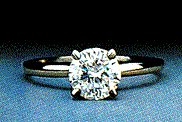Molecule of the Month
 Diamond
Diamond

Diamond has been prized for centuries as a gemstone of exceptional brilliance and lustre. But to a scientist diamond is interesting for its range of exceptional and extreme properties. When compared
to almost any other material, diamond almost always comes out on top. As well as being the hardest known material, it is also the least compressible, and the stiffest material, th
e best thermal conductor with an extremely low thermal expansion, chemically inert to most acids and alkalis, transparent from the deep uv through the visible to the far infrared, and is one of the few materials known with a negative electron affinity (or work function).
|
|
|
| Diamond lattice | Graphite lattice
|
You'll need a Java-aware browser for these images to work properly. If you haven't got one, please view the HTML-only page, the Chime-enhanced page, or go to the main MOTM page to find out more details.
Diamond and Graphite
Diamond is composed of the single element carbon, and it is the arrangement of the C atoms in the lattice that give diamond its amazing properties. Compare the structure of diamond and graphite, both composed of just carbon. In d
iamond we have the hardest known material, in graphite we have one of the softest, simply by rearranging the way the atoms are bonded together.
The relationship between diamond and graphite is a thermodynamic and kinetic one, as can be seen in the phase diagram for carbon. At normal temperatures and pressures, graphite is only a few eV more stable than diamond, and the
fact that diamond exists at all is due to the very large activation barrier for conversion between the two. There is no easy mechanism to convert between the two and so interconversion requires almost as much energy as destroying the entire lattice and re
building it. Once diamond is formed, therefore, it cannot reconvert back to graphite because the barrier is too high. So diamond is said to be metastable, since it is kinetically stable, not thermodynamically stable. Diamond is created deep underground under conditions of extreme pressure and temperature. Under these conditions diamond is actually the more stable of the two forms of carbon, and so over a period of millions of ye
ars carbonaceous deposits slowly crystallise into single crystal diamond gemstones.
Natural diamonds
Natural diamonds are classified by the type and level of impurities found within them.
- Type Ia diamond - Most natural diamonds are of this type, which contain up to 0.3% nitrogen.
- Type Ib diamond - Very rare (~0.1%) in nature, but almost all synthetic (industrial) diamonds are of this type. They contain nitrogen at concentrations of up to 500 ppm.
- Type IIa diamond - Very rare in nature, these diamonds contain so little nitrogen that it can't be easily detected by the usual IR or UV absorption measurements.
- Type IIb diamond - Extremely rare in nature. These have such a low concentration of nitrogen (even lower than type IIa) that the crystal is a p-type semiconductor (due to uncompensated B acceptor impurities).
Synthetic Industrial Diamond
These have been made since the early 1950's, by a process called High Pressure High Temperature synthesis (HPHT). This is an attempt to mimic the conditions under which natural diamond forms deep in the earth. Graphite is put in
to a huge hydraulic press at high temperatures and pressures, and with the addition of a metallic catalyst, converts to diamond over a period of a few hours. The diamond crystals that are produced by this method are typically a few mm in size, which are
too flawed for use as gemstones, but are extremely useful as hard-wearing edges on cutting tools and drill-bits.
Thin Film Diamond
This is a relatively recent development (past 10 years or so), which allows thin films (µm to mm) of polycrystalline diamond to be deposited onto a range of materials, using a technique called Chemical Vapour Deposition (CVD)
. This is creating a great deal of excitement in the academic community, since for the first time we have access to all the superlative properties of diamond in a form that is useful for engineering applications. We can imagine hard-wearing diamond coat
ings on machine parts, diamond windows, diamond electronics, diamond displays, diamond fibre reinforcements, and a whole host of other applications. A review of the recent developments in this area can be found here.
 A CVD polycrystalline diamond film.
A CVD polycrystalline diamond film.
References:
- J.E. Field, The Properties of Natural and Synthetic Diamond, Academic Press, London, 1992.
- F.P. Bundy, The P,T Phase and Reaction diagram for elemental Carbon, 1979; J. Geophys. Res. 85 (B12) (1980) 6930.
- Acknowledgments to Cambridge Crystallographic Database at the Daresbury CDS for supplying the crystal structures of diamond and graphite.

Paul May,
University of Bristol, School of Chemistry.
 Diamond
Diamond Diamond
Diamond
 A CVD polycrystalline diamond film.
A CVD polycrystalline diamond film.
